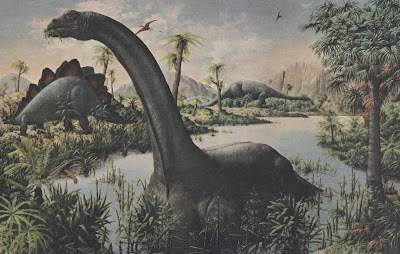ART, FLOWERS AND DINOSAURS

The famous scientist and naturalist Loren Eiseley explained how flowers made human beings possible.
100 million years ago, wrote Eiseley, there was no such thing as a flower. The world was covered with monotonous green vegetation. The inhabitants of that long ago world were mostly cold-blooded creatures with low metabolic rates and small brains driven only by the instinct for the hunt. Their metabolisms made them slaves to weather and limited their lives--they mostly slept through winter, immobilized.
In this reptilian world, our ancestor was an unpromising little mammal who cowered at the losing end of the food chain. According to Eiseley, "man was still, like the genie in the bottle, encased in the body of a creature about the size of a rat."
Then during the cretaceous period, flowering plants (angiosperms with encased seeds) exploded into the world to rescue us. The age of flowers brought us seeds, fruits and nectars-- a totally new store of energy in concentrated form. This energy source enabled us to realize our potential by sustaining our higher metabolic rate. It brought about the rise of birds and mammals, with a more constant body warmth and efficiency and with newly agile brains. Warm blooded birds and mammals depended on high oxygen consumption and food in concentrated forms only provided by flowering plants. As a result of these "supreme achievements in the evolution of life," the human race was on its way:
Without the gift of flowers and the infinite diversity of their fruits, man and bird, if they continued to exist at all, would be today unrecognizable....man might still be a nocturnal insectivore gnawing a roach in the dark. The weight of a petal has changed the face of the world and made it ours.For me, art plays a role similar to the role of Eiseley's flowers. It concentrates our everyday experience into denser packets of visual and emotional nutrition that we can carry with us in our minds and unpack as we go.
Art might take the form of that "special song" that sets your heart to racing, or a poem that is an intense nugget of content that slowly unfolds within you upon reflection. But whatever its form, the invention of art acts like the invention of flowering angiosperms; it allows humans to ingest experience in more intense and digestible forms. It helps our higher metabolism-- intellectual, emotional, visual, amatory-- process the fuel of everyday life.
And it propels us another inch down the road from that "nocturnal insectivore gnawing a roach in the dark."


